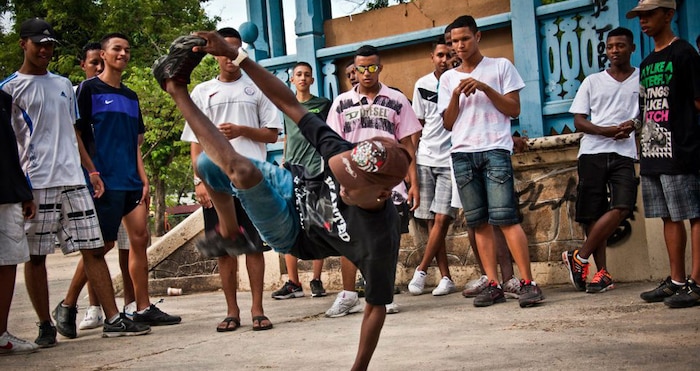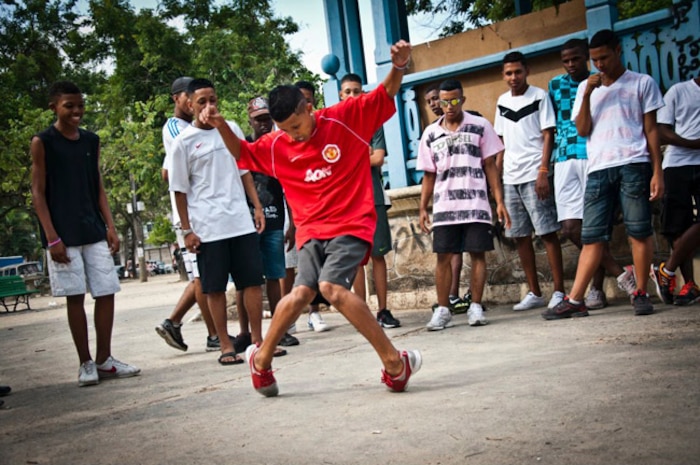Passinho: Footwork in Rio
Passinho is a street dance that has conquered the hills and suburbs of Rio de Janeiro. And while it translates as “small step,” it’s more like a giant leap for the way the city perceives itself on both sides of the social divide.


The motorbike taxi climbs the steep morro (hill) to Chapéu Mangueira, one of the oldest communities in Rio de Janeiro, tucked behind Sugarloaf Mountain. A sign at the side of the road states flatly “You Are Entering A UPP Zone,” meaning this is one of 31 wards in the city where the police’s Pacification Unit have been deployed to quell the drug factions – all part of Rio’s preparations for the two mega-events on the horizon, next year’s FIFA World Cup and the 2016 Olympics.
The bike pulls up outside the CETEP high school. It’s December, when the city takes its summer holidays, but there’s a buzz of activity inside the gates. A DJ, on turntable duty, stands impassively at the far end of the schoolyard. A podium is being constructed on the floor for a trio of judges. And, in the middle, a dance cypher is beginning to take shape.
Wiry, limber youths, some in baseball caps, others with designs etched into their close-shaved hair, stare from the sidelines as each dancer takes his turn in the middle. On display is a blur of light-speed footwork and body moves. It’s a patois of Brazilian dance styles, with snatches of samba, freestyle and frevo. The style is called passinho, literally “small step,” and is the latest groove to captivate young cariocas (Rio’s born-and-bred).
It was in Jacarezinho, way out in Rio’s Zona Norte, that passinho was accidentally born in 2007. This densely populated community was known for throwing some of the wildest bailes funk (funk dances) with thousands of partygoers, big-name MCs and DJs and a staggering wall of speakers, jacked into the power grid by the gatos (pirates).
The baile was bankrolled by the Comando Vermelho, one of the city’s most renowned drug factions – as much an exercise in community PR as in supply-side economics. “It wasn’t hard to spot the bandits at Jacarezinho,” explains Julio Ludemir, author and cultural producer. “They were the ones with the most beautiful women, throwing money about. There was even a bandit dance style – a sort of drunken swagger, with your gun pointed in air.
“But on this particular night, one of the Comando Vermelho’s foot soldiers was creating a real scene. He was drunk, probably high, and was looking for attention. He knew how to dance and started messing around, doing this new step – in Portuguese it’s called passo.”
The next day, people were still talking about the antics of the previous night. Three friends from the morro, Baianinho, Nino and FB, asked the bandit – now deceased – to teach them the dance. By the time the next party came around, the new dance was spreading. And because of the high profile of the Jacarezinho party, it soon spread across the city, first fanned by word of mouth and then via the web.
One of the first dancers to make waves on YouTube was Beiçola (Big Lips). The clip, “Passinho Foda,” shows him and three friends fooling around at an afternoon barbecue. Filmed on a handheld camera, it became an instant hit, and has racked up more than four million views.
In just a few weeks, copycats video started appearing. There was “Passinho da Cidade Alta,” after the suburb where it was filmed. A group of dancers do their thing in front of a Volkswagen Fox, its boot filled up by a hefty speaker box. Then videos started coming in from other parts of the city – Cidade de Deus, Complexo do Alemão, Maré – each dancer determined to catch some fame for themselves and their ends.
Search YouTube and you’ll find thousands of homemade passinho clips, starring muleques (kids) as young as seven years old. Some are filmed in bedrooms just wide enough for a single bed, others on narrow staircases that climb the morros, and some on rooftops, giving widescreen views of the city.
One video, which was aired on the Globo TV network, was by Camarão Preto (Black Shrimp). “I’d been going to bailes since I was about ten and when I started to see passinho at the parties, I instantly liked it,” he says. “I first uploaded a video to Orkut in around 2007 and it’s become one of the most popular clips with more than a million hits. They showed it on Globo TV, so it made me something of a celebrity in my own community, Cidade Alta, but also means that I get recognised outside.”
Passinho represents yet another evolutionary leap in funk carioca, the musical genre from Rio’s favelas that was propelled into the international limelight by Diplo and M.I.A. in 2005. As its name suggests, the scene actually began back in the ’70s when James Brown rocked dancefloors, yet it has managed to consistently reinvent itself every few years.
Julio Ludemir explains, “Passinho dancers, a few years back, occupied a marginal space in the baile funk where they could show off their repertoire. But, little by little, they’re changing everything about the parties – the music, the rhythm, the way people dance. They need a different kind of beat to move to, so they’re looking for particular bailes funk where you have that particular sound. They found it in [places like] Mandela and Parque Reunião, those few bailes where they can have a good time.”
Passinho dancers have started drawing attention away from what have become staples of the bailes funk in recent years, the hypersexualised lyrics and X-rated dances known as putaria – a phrase which needs no translation. Putaria has no end of critics, both within and outside the funk scene, and it has helped to stigmatise the music and its legions of fans. Sex sells, though. So in the favelas you’ll often find free-market economics at its most naked.

That’s why, for many, the stakes for passinho are high. It’s not just a question of dancefloor politics, it’s also the way the favelas and suburbs of Rio are perceived by the population at large. “It’s no different to what happened with samba. 20 years ago, samba was underground music. It’s not any more. Samba became a middle class thing, and for that to happen, it had to make concessions. Today, it’s time for funk to be recognized as a legitimate form of expression, and passinho is helping to accomplish that,” says Ludemir.
In 2011, Ludemir organized the first Batalho do Passinho (The Passinho Battle), which pitted dancers from across the city in a series of elimination contests. He invited filmmaker Emílio Domingos (director of hip-hop doc, L.A.P.A) to judge the contests, but the partnership turned into something much bigger than anticipated.
“Within about five minutes of seeing the dancers, I knew I needed to make a movie about passinho,” says Domingos. “Initially it was just going to be a short film, but as I starting getting to know the dancers, I realised there was a much bigger story to tell.” The resultant documentary, O Batalho do Passinho, entirely self-financed, picked up the New Directions award at the prestigious Festival do Rio, and is now on the festival circuit.
Back at Chapéu Mangueira, the battle has come to an end. The winner is being paraded around the gym on the shoulders of his friends. The emotion of the occasion has got to him, and he can’t fight back the tears. Elsewhere in the schoolyard, dancers are still squaring off against each other, and a scuffle momentarily breaks out – a case of sour grapes over a judge’s decision. The police officers stationed outside the school quickly file into the gym, but it’s already over by the time they arrive.
The leader of the youth organization, Da Teu Papo, which has helped organise the event, gets on the podium and takes the microphone. “The success of today’s event,” he says, “demonstrates just what the youth of the favela are capable of. We’re responsible for building a future, and for that we’re going to have to change ourselves, and our environment.” It’s a big challenge. But, right now, there’s plenty of reason for optimism.